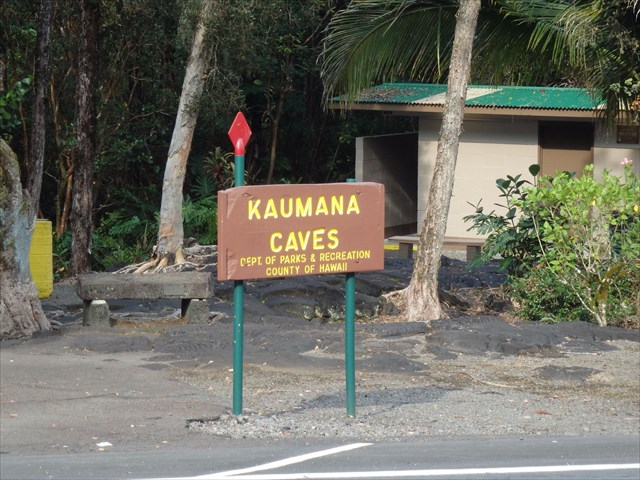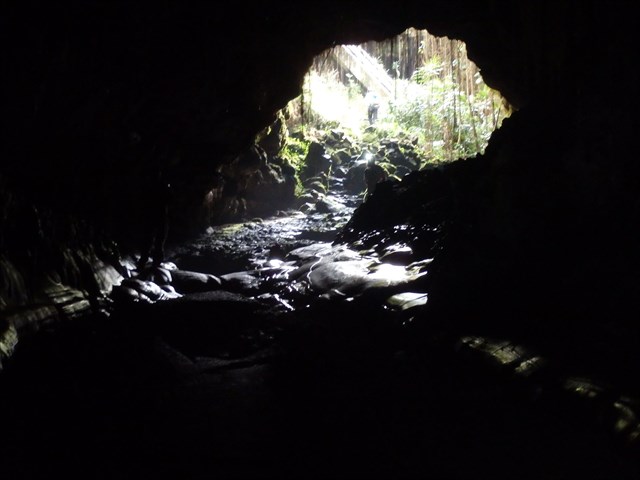
This lava tube at Kaumana Caves was formed by a flow from an eruption of Muana Loa that threatened the city of Hilo. It started on November 5th 1880 and didn’t finish until August 5th 1881. History has it that Princess Ruth Ke`elikolani camped directly in front of the advancing lava flow and stood praying, beseeching the goddess Pele to spare the city. The flow stopped just 2km from the city so it would appear that her prayers were answered.
A lava cave is any cave formed in volcanic rock. Lava tubes are the most common and most extensive kind of lava cave. They are formed when an active low-viscosity lava flow develops a continuous and hard crust. The outer layer of lava cools and thickens to form a roof above the still-flowing lava stream.
When the supply of lava stops at the end of an eruption or lava is diverted elsewhere, lava in the tube system drains downslope and leaves partially empty cave-like conduits beneath the ground.
Tubes can be actively draining lava from a volcano during an eruption, or can be extinct, meaning the lava flow has ceased and the rock has cooled and left a long, cave-like tunnel.
Such drained tubes commonly exhibit step marks or shorelines (like bathtub rings) on their walls. In geological terms they are called a lava subsidence terrace. These indicate the various depths at which the lava flowed for a period of time and are known as flow ledges or flow lines depending on how prominently they protrude from the walls.
A tube-in-tube can form if the linings of the walls are weak enough to lean inward, forming a new floor above the old. Tube-in-tubes generally form as the last lava drains through the main lava tube.
Lava tubes generally have pahoehoe (said as pahoyhoy) floors and may contain stalactite forms generally known as lavacicles. The generic term "lavacicle" has been applied to lava stalactites and stalagmites indiscriminately and evolved from the word "icicle".
A key difference between limestone stalagmites and lava stalagmites is that once the lava has ceased flowing, so the stalagmites will cease to grow. This means if the stalagmite is broken it would never grow back. Stalagmites in lava tubes are rarer than their stalactite counterparts because during formation the dripping material falls onto still-moving lava floors that absorb or carry the material away.
A runner is a bead of lava that extrudes from a small opening and then runs down a wall. Lava tubes may also contain mineral deposits that most commonly take the form of crusts or small crystals of contrasting colour.
Skylights form when a section of the lava tube roof collapses. A lava tube can have several skylights along its length.

The coords will take you to a skylight formed when part of this lava tube’s roof collapsed. The entrance is through this skylight which is about 30km (18 miles) from the lava tube's starting point. A concrete staircase leads down to the floor of the lava tube. Lush foliage surrounds the opening and plant and tree roots extend through the ceiling of the tube.
This lava tube at Kaumana Caves is 40km long (25 miles). The internal size of the lava tube varies from very narrow to very wide along its entire length. Wear sturdy shoes and bring a headlamp or flashlight if you plan to explore much beyond the opening of the lava tube.
Remember to take only photos and leave no trace of your visit. We hope you enjoy your visit to this Hawaiian volcanic geological formation.
To log this Earthcache: once inside the lava cave and you have had a good look around you may log this Earthcache straight away. Then please email your answers to the questions to the CO. We will contact you ONLY if your answers need extra work. Logs with no answers sent will be deleted.
1. Why do you think the floor of the lava tube is so uneven when the lava was originally a molten flowing stream?
2. Describe the lava textures in and around the ‘bathtub’ about 20m in on the right side of the lava-cave. How deep is it?
3. Describe two GEOLOGICAL features you see in the lava tube and tell about how far inside you ventured to find them.
This Earthcache was developed with knowledge and information gained after a week-long study of the volcanic processes on Big Island with the Geoventure group led by leaders from the Geological Society of America. Other sources of information are attributed with thanks as follows:
http://en.wikipedia.org/wiki/Lava_tube
http://en.wikipedia.org/wiki/Lava_cave
www.hawaiiweb.com/kaumana-cave-hawaii-the-big-island.html
